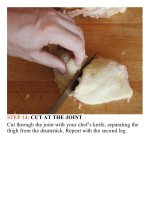The food lab better home cooking through science ( PDFDrive ) 775
Bạn đang xem bản rút gọn của tài liệu. Xem và tải ngay bản đầy đủ của tài liệu tại đây (192.42 KB, 2 trang )
Score:
•CommandmentI:PerfectCrust?Negative
•CommandmentII:NoGrayZone?Check.
•CommandmentIII:Full-onJuiciness?Unknown.
TheMythoftheSear
Jump back a couple of decades and the solution to my
dilemmawouldhavebeenobvious.Itwasacommonlyheld
belief (and still is by many home cooks and professional
chefsalike)thatinordertohelparoast,steak,orchopretain
moisture, you should first sear it, creating a crust that will
“lockinthejuices.”Now,anyonewhohasreadtheirHarold
McGee or has ever seen juices squeeze out through the
searedsideofasteakafteryouflipitoveronthegrillknows
that this can’t possibly be completely true. But what about
partiallytrue?Couldasearactuallyhelpretainatleastsome
of the juices? In order to test this, I cooked two roasts cut
from the same rib sections, with comparable surface areas,
weights, and fat contents according to the following
processes:
•Roast1:Searedinapanin3tablespoonscanolaoilover
high heat on the stovetop until a well-browned crust
formed (about 15 minutes), then transferred to a 300°F
oven and roasted to an internal temperature of 120°F,
removed, and rested for 20 minutes (during which time
the temperature in the center rose to 125°F and then
droppedbackdownto120°F).
• Roast 2: Roasted in a 300°F oven to an internal
temperature of 120°F, removed, and seared in a pan in 3
tablespoonscanolaoiloverhighheatonthestovetopuntil
a well-browned crust formed (about 8 minutes), then
rested for 20 minutes (during which time the center
temperatureroseto125°Fandthendroppedbackdownto
120°F).
PERCENTAGERETAINED
WEIGHTVERSUSSEARING
ORDER









